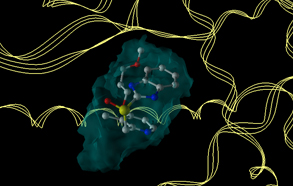| |
|
| Products > VLifeMDS > VLifeDock |
|
|
|
|
|
|
VLifeDock provides users with a choice of methods for molecular docking.
Three methods, Grid based docking, GA docking and VLife's own GRIP docking offer unique 'Accuracy - Speed' options to the user from rapid screening to exhaustive precison docking.
VLifeDock also has batch docking facility to enable prioritizing the ligands based on their binding scores easily. The choice of systematic and stochastic methods with an array of scoring functions makes VLifeDock a truly versatile application.
VLifeDock is available for both Linux and Windows® operating systems. |
| |
 |
| |
|
Systematic methods
A Grid based algorithm is implemented within VLifeDock for systematic docking. The algorithm exhaustively explores binding mode of ligand over a grid on the protein cavity. The Grid based method is a type of rigid docking where both the ligand and receptor are treated as rigid. |
Stochastic methods
A genetic algorithm based method employed in VLifeDock provides a stochastic method for docking. GA based docking in VLifeDock takes flexibility of ligand into consideration. It generates a wide population of initial poses, which ultimately evolve into the optimal binding mode. |
GRIP docking
GRIP is a rapid yet accurate docking methodology developed by VLife and available exclusively through VLife software. The GRIP scoring function enables fast and precise capturing and prediction of ligand - receptor interactions in the active site of proteins. GRIP docking is available as rigid as well as flexible docking, where unique conformers of a set of ligands are taken as input. |
Scoring functions
VLifeDock provides an array of scoring functions such as PLP score, XCscore and Steric + Electrostatic score for evaluation of docked poses. |
|
|
|
 |
| Interacting residues information after docking FK-041 ligand into human PBP protein |
|
|
|
Peer reviewed algorithms
Algorithms in VLifeMDS have wide acceptance in scientific community. These algorithms are either published or are patent pending. There are multiple case studies of research conducted with VLifeMDS. |
Ease of plug-in / plug-out
Although an integrated platform, VLifeMDS has a modular architecture. Customers can buy the whole suite in one-go or buy incrementally as per the evolving needs of their research projects. Incremental module additions seamlessly integrate with rest of the modules to provide a consistent experience. |
Ease of customization & integration
VLifeMDS is developed fully in-house with complete ownership of every line of code. This provides unprecedented flexibility to add-on/ customize the product to suit customer specifications as well as integrating it to customers' existing discovery workbench. |
|
|
|
|
| |
|
 |
Application of enzymes to enhance drug action View |
 |
Target Identification for existing nutraceutical molecule View |
 |
Homology modeling using BioPredicta View |
|
|
|
|
|
|
|
|
|
|
|
|
|
| Conformer, force field analysis |
|
|
|
| |
|
|
| LeadGrow |
| Combinatorial library generation |
|
|
|
|
|
|
|
|